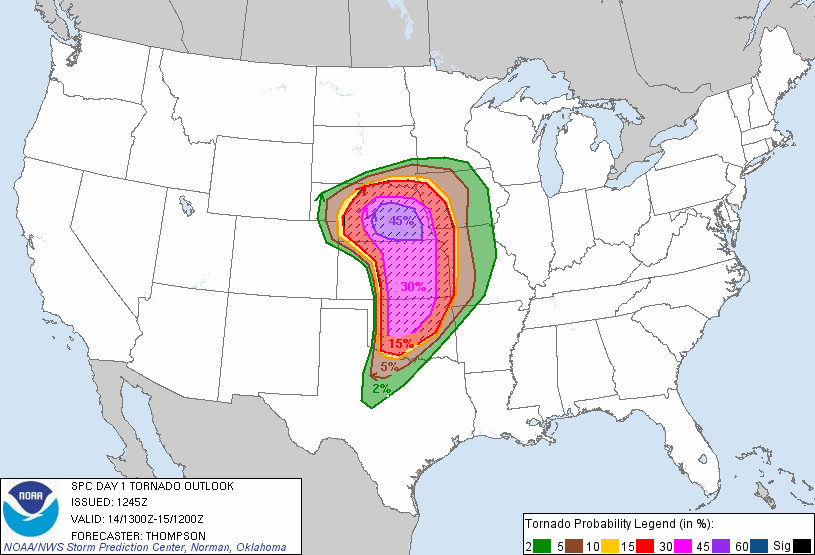**What are the chances of a tornado today?**
If you live in an area prone to tornadoes or if severe weather is forecasted, you may find yourself asking this question. Tornadoes are one of nature’s most powerful and destructive forces, capable of causing immense damage and loss of life. Understanding the likelihood of a tornado occurring can help us prepare and stay safe. In this article, we will explore the factors that influence tornado formation and discuss how meteorologists calculate the chances of a tornado occurring on any given day.
**Tornado Formation**
Tornadoes typically form within severe thunderstorms, which are characterized by strong updrafts and intense rotation. These updrafts, often fueled by warm and moist air, create an environment where tornadoes can develop. When these rotating updrafts become more organized, a mesocyclone forms, which is a key precursor to tornado formation. The mesocyclone’s rotation can then be tilted vertically by wind shear, creating a favorable condition for a tornado to touch down.
**The Role of Instability and Wind Shear**
Two primary atmospheric factors contribute to the formation of tornadoes: instability and wind shear. Instability refers to the potential energy available for the atmosphere to vertically move air parcels. When warm and moist air near the surface encounters cooler air aloft, it becomes buoyant and rises rapidly. This vertical motion creates strong updrafts and enhances storm development. Wind shear, on the other hand, refers to the change in wind direction and speed with height. A significant change in wind direction helps to create rotation within a thunderstorm, providing the necessary ingredients for tornado formation.
**Forecasting Tornadoes**
Forecasting tornadoes is a complex task that requires the analysis of multiple meteorological factors. Meteorologists use a variety of tools and techniques to assess the atmospheric conditions and make predictions. Some of the key tools include weather radar, satellite imagery, and numerical weather prediction models.
Weather radar, such as Doppler radar, plays a crucial role in tornado prediction. It can detect the presence of severe thunderstorms and the rotation within them. Weather radar data combined with other observational data can help meteorologists identify the potential for tornado development. Satellite imagery provides a broader view of the atmosphere and helps in tracking storm systems that could lead to tornado formation. Numerical weather prediction models use advanced mathematical algorithms to simulate the atmosphere and predict its behavior. These models consider various factors such as temperature, humidity, wind, and pressure patterns to predict severe weather events.
**Tornado Risk Assessment**
To assess the chances of a tornado occurring on any given day, meteorologists use the Storm Prediction Center’s (SPC) Convective Outlook. The Convective Outlook considers various atmospheric parameters and categorizes the severe weather risk into five levels: Marginal, Slight, Enhanced, Moderate, and High. These categories reflect the likelihood and intensity of severe weather, including tornadoes.
The SPC uses a combination of observational data, forecast models, and expert analysis to produce the Convective Outlook. This outlook provides valuable information for emergency management agencies, forecasters, and the general public to prepare for severe weather events.
**Frequently Asked Questions**
Frequently Asked Questions
1. Can tornadoes be accurately predicted?
While meteorologists have made significant progress in tornado prediction, it is still challenging to pinpoint the exact time and location of a tornado. The forecasting tools and techniques used today help identify the potential for tornado formation and issue warnings. However, tornadoes can still develop rapidly and without much warning, making it essential to stay alert during severe weather.
2. What are the chances of a tornado hitting my area?
The likelihood of a tornado hitting a specific area depends on multiple factors, including geographical location and climatic conditions. Tornadoes are more common in tornado-prone regions, such as Tornado Alley in the United States. However, tornadoes can occur in other parts of the world as well. It is essential to stay informed about local weather forecasts and be prepared for severe weather events.
3. How much time do we have to seek shelter when a tornado warning is issued?
The amount of time you have to seek shelter when a tornado warning is issued can vary. It depends on factors such as the speed at which the tornado is moving and the distance between the storm and your location. It is crucial to have a plan in place and be prepared to take immediate action when a tornado warning is issued.
Final Thoughts
Understanding the chances of a tornado occurring can help us take necessary precautions and stay safe during severe weather events. While tornadoes can be devastating, advancements in meteorological science and technology have improved our ability to predict and forecast these destructive storms. By staying informed and prepared, we can mitigate the risks associated with tornadoes and protect ourselves and our communities. Remember to follow the guidance of local authorities and seek shelter when severe weather warnings are issued. Stay safe!
